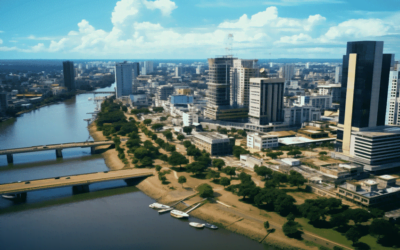Hey there, fellow drone enthusiasts and curious minds, I get it—you’ve got that burning question about Saint Kitts and Nevis drone laws on your mind.
You’re not alone; I’ve been there too, searching high and low for the inside scoop. So, here’s the deal: I’ve done the legwork and the research, and I’m here to spill the beans on everything you need to know.
Now, you might be wondering, “Who am I to be your guide in the realm of drone regulations?” Well, I’m just like you—passionate about drones and eager to explore the world from above.
I dove into the depths of Saint Kitts and Nevis drone laws, and I’ve got the answers you’re seeking. It wasn’t easy, but I’ve uncovered the rules and regulations, so you don’t have to sift through the noise.
So, if you want to soar through Saint Kitts’ skies with your drone without breaking a sweat, keep reading. In this article, I’m going to break down the nitty-gritty of drone laws in Saint Kitts and Nevis.
I’ll cover everything from where you can fly to how to get that all-important permit to the do’s and don’ts to keep you out of trouble. You’re in good hands; I’ve got your back on this journey through the world of Saint Kitts and Nevis drone laws. Let’s get started!
- Saint Kitts and Nevis Drone Laws Regulatory Authorities
- Saint Kitts and Nevis Drone Categories
- Saint Kitts and Nevis Drone Rules for Hobbyists
- Drone Rules for Commercial Operators in Saint Kitts and Nevis
- Traveling with Drones to Saint Kitts and Nevis
- Obtaining a Drone License in Saint Kitts and Nevis
- Flying Drones in Protected Areas in Saint Kitts and Nevis
- Drone No-Fly Zones in Saint Kitts and Nevis
- Final Thoughts on Saint Kitts and Nevis Drone Laws
- Frequently Asked Questions About Saint Kitts and Nevis Drone Laws
Saint Kitts and Nevis Drone Laws Regulatory Authorities

Let’s dive into the nitty-gritty of Saint Kitts and Nevis drone laws and get a handle on the people who keep things in check. You see, when it comes to regulating drones in this beautiful part of the world, the Eastern Caribbean Civil Aviation Authority, or ECCAA, takes the stage.
The Role of ECCAA
Now, you might be wondering, “Who are these ECCAA folks, and what’s their deal with drones?” Well, they’re like the guardians of the airspace.
ECCAA plays a significant role in overseeing and regulating drone operations in Saint Kitts and Nevis. These regulations aim to ensure the safety and security of both the skies and the people below.
ECCAA, though not drone-dedicated, extends its umbrella of authority to cover drone operations under the broader spectrum of general aviation regulations. This means that while they primarily focus on airplanes and helicopters, they’ve got their eyes on drones too.
These regulations are designed to create a structured and safe environment for drone enthusiasts, hobbyists, and commercial operators alike. So, if you’re planning to take your drone for a spin in Saint Kitts and Nevis, ECCAA is the authority that keeps the airspace in check.
Drone Regulations within General Aviation
Now, about those general aviation regulations – they’re the all-encompassing framework where drone rules find their place. It might seem a tad unusual, but it’s ECCAA’s way of keeping all things aviation in one well-regulated basket.
While you’re out there, you might not always see an ECCAA drone-specific section, but rest assured, the regulations related to drones are housed under the broader umbrella.
It’s all about ensuring the harmonious coexistence of drones and other aircraft, and these regulations serve as the guiding compass for drone operators.
So, if you’re planning to soar the skies or capture breathtaking aerial views in Saint Kitts and Nevis, it’s ECCAA and their general aviation regulations that you’ll want to keep on your radar. They set the stage for safe and responsible drone operations in this tropical paradise.
Also Read: Rwanda Drone Regulation 2024
Saint Kitts and Nevis Drone Categories

Alright, let’s get one thing straight in the world of Saint Kitts and Nevis drone laws – not all drone operators are the same.
There are essentially two categories that make the drone world go around in this picturesque paradise: hobbyists and commercial operators. And yes, you guessed it, they’ve got their own set of rules to follow.
Hobbyists vs. Commercial Operators
So, what’s the deal with these two categories? Well, it’s quite simple. Hobbyist drone operators are the folks who fly drones for pure enjoyment.
No fancy business deals, no clients—just pure drone love in action. On the other hand, commercial operators are the ones who put their drones to work for business, whether it’s photography, surveying, or anything that brings in the moolah.
Now, whether you’re a hobbyist or a commercial operator, there’s one thing that binds you together – you’re here to have fun, explore, and capture some breathtaking shots. But, of course, you need to play by the rules.
Regulations for Both Categories
Here’s where the rules come into play. No matter which category you fall into, some regulations apply across the board. The first one on the list is registration.
That’s right, every drone operator, whether you’re flying for fun or profit, needs to register your drone with the Saint Kitts and Nevis Civil Aviation Authority. It’s like getting your drone an official ID card—a way to keep things legit and above board.
But there’s more to it than just registration. Permits are another essential aspect. Commercial operators, in particular, need to secure permits before they take flight.
It’s the way Saint Kitts and Nevis ensures that everything is smooth and safe in the skies. So, no matter your category, these regulations are the foundation of responsible drone flying in this stunning part of the world.
Also Read: Russia Drone Regulation 2024
Saint Kitts and Nevis Drone Rules for Hobbyists

Now, let’s talk shop about the drone rules for all you hobbyist pilots out there. You’re not in it for profit; you’re here to have a blast and capture some epic footage. Well, guess what? There are rules for you too, but don’t worry; they’re all about keeping things safe and fun.
Key Regulations and Best Practices
Hobbyist drone operators, listen up. When you’re taking your drone for a spin in Saint Kitts and Nevis, a few key regulations and best practices should always be on your checklist. First and foremost, always keep your drone within your line of sight.
That’s right, no flying around blind corners or beyond the horizon. It’s all about safety and making sure you have full control.
Line of Sight, Altitude, and Weather
While you’re up there, remember to play it safe. There’s an altitude restriction – don’t go higher than 400 feet above ground level. And when it comes to weather, well, it’s simple. Only fly when the conditions are good. Clear skies and gentle winds are your best pals when you’re piloting your drone.
Respecting Privacy and Local Restrictions
Respect is the name of the game when it comes to privacy. Avoid capturing images of people without their consent, and don’t be a nosy neighbor with your drone.
As for local government restrictions, stay informed. Know the no-fly zones and the places where drone flying is a big no-no. Keep it respectful, and you’ll have a blast capturing Saint Kitts and Nevis from the sky.
Also Read: Romania Drone Regulation 2024
Drone Rules for Commercial Operators in Saint Kitts and Nevis

Alright, commercial operators, it’s your time to shine in the Saint Kitts and Nevis drone world. While hobbyists are out there capturing the magic, you’re putting your drones to work. But, of course, with great business comes great responsibility. So, let’s break down the rules for commercial drone operators.
Specific Regulations for Commercial Operators
Now, commercial operators, you’ve got some specific regulations to keep in mind. First and foremost, when you’re running a drone business in Saint Kitts and Nevis, you need a permit. That’s the golden ticket that says you’re good to go. It’s like the official stamp of approval from the authorities.
The Need for Drone Insurance
Now, here’s a biggie – insurance. When you’re flying commercially, having drone insurance is a must. It’s like having a safety net. You never know when accidents might happen, and having that insurance is your way of saying, “I’ve got this covered.”
Altitude, Airports, and Daylight
But there’s more to it. Remember the altitude restriction? It’s the same for you too – no going higher than 400 feet above ground level. And when you’re near airports or restricted airspace, steer clear. It’s a big no-no. Also, daytime is your playtime.
Commercial drone operations are a daylight affair, ensuring you’ve got the best visibility and safety. So, as a commercial operator, these rules keep everything running smoothly, safely, and in the best interest of all.
Also Read: Qatar Drone Regulation 2024
Traveling with Drones to Saint Kitts and Nevis

Now, let’s talk about something every drone enthusiast needs to know – how to travel with your precious flying machine. Whether you’re heading to Saint Kitts and Nevis or jet-setting anywhere else, your drone needs special treatment.
Transporting Drones by Airplane
First things first, when you’re taking your drone on an airplane journey, it’s like bringing a VIP guest along. You’ve got to ensure it travels comfortably and safely. Most importantly, keep your drone in your carry-on luggage. You don’t want your prized possession to end up in the abyss of checked baggage.
Drones in Carry-On, Batteries in Check-in
And speaking of batteries, here’s a golden rule – never, ever place your drone batteries in your checked baggage. Lithium-ion batteries, like the ones in drones, are considered “dangerous goods” by airlines. So, you’re better off having them right by your side in your carry-on bag. It’s not just about rules; it’s about safety too.
Beware of Lithium-Ion Battery Risks
Now, why all this fuss about lithium-ion batteries? Well, there’s a reason. Mishandling these batteries can lead to a whole lot of trouble, from the airline seizing them to fines or even being denied boarding.
Safety is key, so when you’re traveling with your drone, make sure you follow these rules. Your drone will thank you for it, and so will your fellow travelers.
Also Read: Portugal Drone Regulation 2024
Obtaining a Drone License in Saint Kitts and Nevis

Alright, fellow drone enthusiasts, if you’re looking to take your drone game to the next level in Saint Kitts and Nevis, you’ll need a drone license. Don’t worry; I’ve got the lowdown on how to make that happen.
The License Procurement Process
So, let’s talk about the process. It starts with filling out an application form. You can get this from the Ministry of National Security’s website. It’s like the first step in your drone journey.
Application Requirements
Now, here’s where you need to have your paperwork in order. Along with the application form, you’ll need to pay a non-refundable fee of US$100.
That’s your ticket to the drone club. You’ll also have to provide a copy of your valid passport or driver’s license, a valid credit card, and a letter of authorization from the drone’s owner if it’s not yours.
Steps to Drone License Glory
Once you’ve got all your documents in order, the Ministry of National Security will review your application. If all’s well, they’ll issue your drone license within 30 days. But that’s not the end of the journey.
You’ll also need to register your drone with the Saint Kitts and Nevis Civil Aviation Authority (SKNCAA). Then comes the online course and a test administered by the SKNCAA.
Keep in mind, though, that if you don’t follow the drone regulation handbook to the letter, your license could be at risk. And remember, it’s an annual renewal, so keep that calendar marked.
Also Read: Poland Drone Regulation 2024
Flying Drones in Protected Areas in Saint Kitts and Nevis

Exploring the stunning natural landscapes in Saint Kitts and Nevis with your drone is a dream come true. But, like any good adventure, it comes with rules and responsibilities. Let’s dive into the specifics of flying drones in those protected areas.
Rules and Regulations
Protected areas, you see, are there for a reason – to protect the environment and its wildlife. So, when it comes to drones, you’ll want to follow the rules closely. This includes steering clear of those no-fly zones, like national parks, nature reserves, and other government-governed areas.
The Importance of Authorization
Now, to fly your drone in these protected areas, you’ll typically need the green light from the government. That’s non-negotiable.
And it makes sense. You wouldn’t want your drone buzzing over a serene nature reserve or, heaven forbid, disrupting a group of people who are out there enjoying nature’s wonders.
Type-Specific Restrictions
Here’s where it gets a bit nuanced. Different protected areas might have their own set of rules. Some may limit the types of drones that can be flown, while others might restrict the maximum altitude. It’s like getting to know the unique character of each protected area you visit.
So, make sure to check with the relevant government agency to get all the details. Remember, it’s not just about rules; it’s about respect and preserving these wonderful places for generations to come.
Also Read: Philippines Drone Regulation 2024
Drone No-Fly Zones in Saint Kitts and Nevis

Imagine flying your drone over the captivating landscapes of Saint Kitts and Nevis, capturing the beauty all around. Now, let’s talk about the no-fly zones and why they matter.
Overview of No-Fly Zones
No-fly zones are essential to ensure safety and respect privacy. Saint Kitts has set up these zones to protect its citizens and preserve the tranquility of certain areas. It’s all about keeping the balance.
Restrictions in Designated Areas
These zones typically include national parks, military installations, and airports. As you can guess, buzzing your drone over a military installation or around an active airport runway wouldn’t be the wisest decision. The rules are in place to avoid accidents and protect national security.
Rules for Commercial Operators
Now, for commercial operators, there are stricter regulations in no-fly zones. They often need to obtain special permits to operate in these areas, and these permits come with conditions.
Plus, you’ll want to be cautious when it comes to photography and recording individuals. It’s important to respect people’s privacy, and capturing them without consent is a big no-no. In the end, it’s about responsible and respectful drone use.
Also Read: Peru Drone Regulation 2024
Final Thoughts on Saint Kitts and Nevis Drone Laws

So, that’s the scoop on drone laws in Saint Kitts and Nevis. Let’s wrap things up with a quick recap and some words of wisdom.
In a nutshell, drone operators in this Caribbean paradise need to adhere to some important rules.
Whether you’re flying for fun or running a commercial operation, keeping your drone within your line of sight, respecting altitude restrictions, and being mindful of no-fly zones are paramount. These rules ensure the safety and privacy of all citizens.
Compliance with these regulations is more than just following the rules; it’s about being a responsible drone operator.
By doing so, we help maintain a harmonious coexistence between technology and the breathtaking natural beauty of Saint Kitts and Nevis.
Lastly, laws can change, and it’s our responsibility as drone enthusiasts to stay updated. New regulations may emerge, and we must keep abreast of them to operate our drones safely and legally. Remember, we’re here to enjoy this beautiful place, and that starts with responsible drone operation.
Frequently Asked Questions About Saint Kitts and Nevis Drone Laws
1. Are drones allowed in Saint Kitts and Nevis?
Yes, drones are indeed allowed in Saint Kitts and Nevis. The Eastern Caribbean Civil Aviation Authority (ECCAA) oversees drone regulations, and while they are somewhat evolving, the use of drones is permitted. However, there are specific rules and guidelines to follow to ensure safe and responsible drone operations in the country.
2. What’s the role of the Eastern Caribbean Civil Aviation Authority (ECCAA)?
The ECCAA plays a crucial role in regulating drones in Saint Kitts and Nevis. Although they don’t have a dedicated website for drones, these regulations are covered within general aviation regulations. The ECCAA ensures the safety and responsible use of drones in the region.
3. Can I fly my drone anywhere in Saint Kitts and Nevis?
While the law permits drone usage, there are restrictions. It’s essential to maintain visual line-of-sight (VLOS) with your drone, except when granted permission by the Air Traffic Control (ATC). Flying over certain areas, like airports, military bases, and crowded spaces, is prohibited. The regulations aim to safeguard public safety, privacy, and the country’s airspace.
4. What are the rules for hobbyist drone operators?
Hobbyist drone operators have certain guidelines to follow, which include maintaining a safe distance from obstacles, not flying above 300 feet, and avoiding nighttime or low-visibility flights without permission. Respecting privacy, avoiding restricted areas, and adhering to local government restrictions are essential.
5. What about commercial drone operators?
Commercial drone operators have additional responsibilities, such as obtaining drone insurance for their operations. They must stay below 400 feet, avoid restricted airspace and airports, and operate only during daylight hours. Adhering to safety regulations is crucial to ensure the safe operation of drones for commercial purposes.













